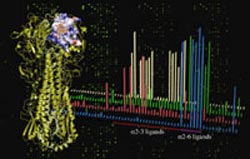New technique for detecting ability of flu viruses to infect humans

WHAT:
NIH-funded scientists at The Scripps Research Institute have developed a technique for detecting changes in flu viruses that would precede a virus’s ability to infect humans and cause epidemics. The new, publicly available tool, called a glycan array, could be used to monitor the emergence of flu strains that efficiently infect humans, including those of avian origin. The technology was developed by the Consortium for Functional Glycomics, a “glue grant” project sponsored by NIH’s National Institute of General Medical Sciences (NIGMS). The National Institute of Allergy and Infectious Diseases also funded the research.
WHY and WHEN:
“Glycoarray Analysis of the Hemagglutinins from Modern and Pandemic Influenza Viruses Reveals Different Receptor Specificities” by Ian Wilson, D.Phil., James Paulson, Ph.D., and their coworkers is scheduled to be published in the February 3, 2006 issue of the Journal of Molecular Biology. The article appeared online on November 18, 2005.
WHO:
Jeremy M. Berg, Ph.D., Director, National Institute of General Medical Sciences, is available to comment on the new technique and how it can be used to detect potentially dangerous flu strains. Berg can also discuss the NIGMS “glue grant” program, which brings together teams of scientists with diverse expertise to tackle complex problems that are of central importance to biomedical science.
Media Contact
All latest news from the category: Life Sciences and Chemistry
Articles and reports from the Life Sciences and chemistry area deal with applied and basic research into modern biology, chemistry and human medicine.
Valuable information can be found on a range of life sciences fields including bacteriology, biochemistry, bionics, bioinformatics, biophysics, biotechnology, genetics, geobotany, human biology, marine biology, microbiology, molecular biology, cellular biology, zoology, bioinorganic chemistry, microchemistry and environmental chemistry.
Newest articles

After 25 years, researchers uncover genetic cause of rare neurological disease
Some families call it a trial of faith. Others just call it a curse. The progressive neurological disease known as spinocerebellar ataxia 4 (SCA4) is a rare condition, but its…

Lower dose of mpox vaccine is safe
… and generates six-week antibody response equivalent to standard regimen. Study highlights need for defined markers of mpox immunity to inform public health use. A dose-sparing intradermal mpox vaccination regimen…

Efficient, sustainable and cost-effective hybrid energy storage system for modern power grids
EU project HyFlow: Over three years of research, the consortium of the EU project HyFlow has successfully developed a highly efficient, sustainable, and cost-effective hybrid energy storage system (HESS) that…





















